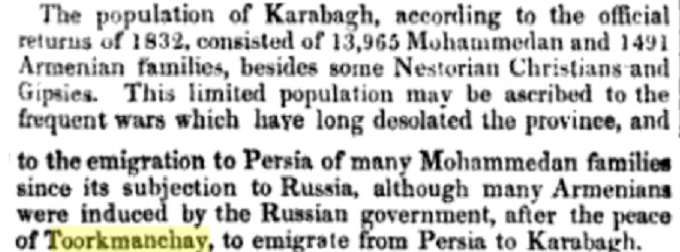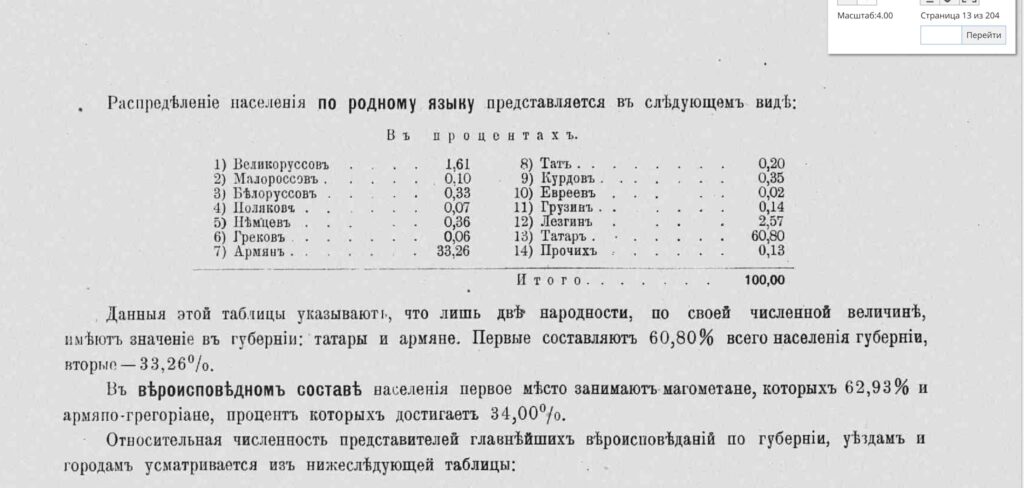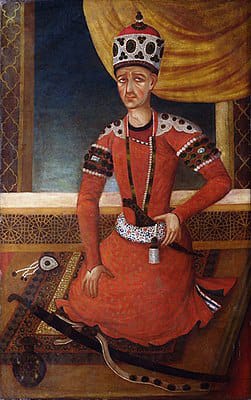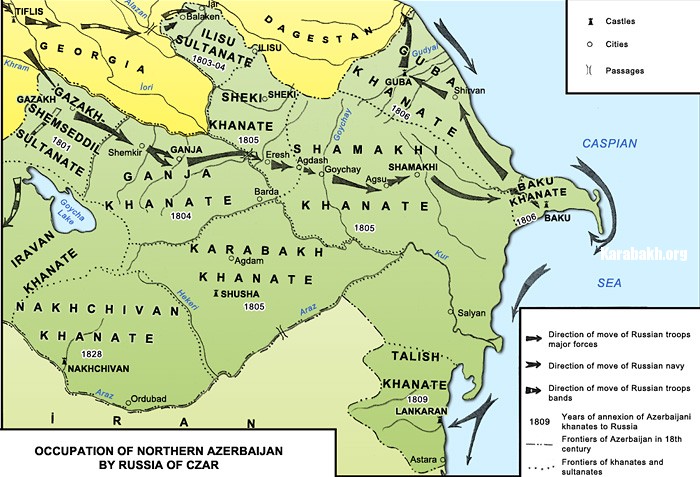19th century became the most important turning point in the ethnic history of Karabakh. Subordination and consequent elimination of the Karabakh khanate gave the Czarist government an opportunity to resettle Armenians in the territory of North Azerbaijan, including Karabakh, to strengthen Russian positions in the region.
The Russian author of 19th century S. Glinka wrote: «…increase of the resettled related Christian people [in Azerbaijan] can place a reliable stronghold in the borders of Russia for repulse of the hostile actions of the neighbouring peoples, particularly, of the Turks, Persians, and the mountaineers»[ref]S. Glinka «Resettlement of the Armenians of Adderbijan to the borders of Russia» (Описание переселения армян аддербиджанских в пределы России). Moscow 1831, Baku 1990, p. 93 (in Russian); under name «Adderbijan» the author means the South (Iranian) Azerbaijan; also online https://www.prlib.ru/item/434748[/ref].
Before the process of resettlement began, Karabakh consisted of 17 counties (mahals). In 12 mahals, if to exclude several Armenian villages, lived almost exceptionally Azeris. The mahals of Dizak, Varanda, Chelaberd and Talish were consisted of the Azeri («Muslim») and Armenian villages. There were also villages where the Armenians and Azeris lived mixed.[ref]«Description of the Karabakh province prepared in 1823 according to the order of the governor in Georgia Yermolov by state advisor Mogilevsky and colonel Yermolov 2nd» (Opisaniye Karabakhskoy provincii sostavlennoye v 1823 g po rasporyazheniyu glavnoupravlyayushego v Gruzii Yermolova deystvitelnim statskim sovetnikom Mogilevskim i polkovnikom Yermolovim 2-m) Tiflis 1866 (hereinafter Description of the Karabakh province…); also: Khalilov K. D. «Regarding the ethnic history of Karabakh» (Iz etnicheskoy istorii Karabakha) cited in the book «History of Azerbaijan based on documents and publications» (Istoriya Azerbaydzhana po dokumentam i publikaciam) ed. Z. Buniatov Baku 1990 p. 38 (in Russian)[/ref]
In the beginning of the 19th century the Czarist officials have made some work to define the number of the population of the Karabakh province.
One source, according to which the number of the Karabakh population in 1805 was 10,000 families, points that in 1808 the number of the families living in Karabakh decreased to 7,474.[ref]AKAK v. 4 p. 579 / Id.[/ref]
All the historical sources confirm the decrease of the number of the Karabakh population during the mentioned period. As known from the history, part of the population of these places left their homes during the war, but returned back as soon as the war was over.
The second important historical document which provides detailed information about the number and ethnic composition of the Karabakh population, is the taxation register of the Karabakh province, prepared by the Russian officials Yermolov and Mogilevsky, soon after the elimination of the Karabakh khanate in 1823. The register provides the number of population village-by-village and family-by-family and also informs about their ethnic belonging. According to the register, the number and ethnic composition of Karabakh population in 1823 is as follows:[ref]Kh. D. Khalilov, From the Ethnic History of Karabakh, History of Azerbaijan from Documents and Publications, Baku: Elm, 1990, op. cit. [61] (X. Д. Халилов, “Их этнической истории Карабаха”, История Азербаиджана по документам и публикациям. Баку: Элм, 1990)[/ref]
| Nationality | Number of families | ||
|---|---|---|---|
| In town (Shusha) | In villages | Total | |
| Azeris («Muslims») | 1,111 (72.5%) | 14,618 (78.7%) | 15,729 (78.3%) |
| Armenians | 421 (27.5%) | 3,945 (21.3%) | 4,366 (21.7%) |
| Total | 1,532 (100%) | 18,563 (100%) | 20,095 (100%) |
It also has to be noted, that of the total Karabakh population, the share of 5 districts situated in the mountainous part of Karabakh, i.e. the districts of Dizak, Varanda, Chelaberd, Khachen and Talish where Azeris and Armenians lived mixed, was 1,559 families (7.75%).[ref]Description of the Karabakh province. op. cit. [61] / Sources on the history of Azerbaijan (Istochniki po istorii Azerbaidzhana). Baku, 1989, p. 263[/ref] Despite its importance, a substantial deficiency of this document was the fact that Armenians – first wave settlers from Iran – were included in the register without provisions.
Resettlement of Armenians increased substantially during the second Russo-Iranian war in 1825-1826. 18,000 Armenian families (40,000 people) were settled in Karabakh, particularly in its mountainous part. This source also shows, that with exception of the villages of Ahlatian, Pirnakhay and Shinatag in Zangezur, the populations of all the Armenian villages were immigrants from Iran.[ref]Zelinsky S. P. «The economic life of the state peasants of the Zangezur district of the Yelizavetpol province» (Ekonomicheskiy bit gosudarstvennix krestyan Zangezurskogo uyezda Yelizavetpolskoy gubernii). Tiflis, 1886, p. 4, p. 10 / Documents and publications, p. 39[/ref]
The massive resettlement process gained additional momentum after conclusion in 1828 of the Turkmanchay Peace Treaty between the Russian Empire and Iran, and the Adrianopol peace accord (1828) with the Ottoman Empire.

According to the Article 15 of the Turkmanchay treaty, the Armenian population of Iran (they were, primarily, the inhabitants of the Southern Azerbaijan occupied at that time by Russians) had been given a right to freely resettle to the regions of the Caucasus during a period of one year. Based on this treaty, first party of 8,249 Armenian families were resettled from Iran and placed in the Erivan gubernia (territory of present-day Armenia), the Karabakh province and the Shemakha district.[ref]Zelinsky S. P. «Tribal composition, religion and origin of the state peasants – Collection of material for studying the economic life of the state peasants of the Transcaucasus region» (Plemennoy sostav, religiya i proizxozhdeniye gosudarstvennix krestyan- Svod materialov po izucheniyu ekonomicheskogo bita gosudarstvennix krestyan Zakavkazskogo kraya). Tiflis, 1882, vol. 2, p. 13 (in Russian)[/ref]
More Armenians were resettled from the Ottoman Empire after war of 1826-28. The Russian author of the end of 19th and beginning of 20th century, N. N. Shavrov, describes all these processes as follows: «After the war of 1826-1828 ended, during the period of 1828-1930 we (i.e. Russia) have resettled to the Transcaucasus more than 40.000 Persian and 84.600 Turkish Armenians and placed them in the best state lands of Yelizavetpol and Erivan provinces, where [the number of] the Armenian population was miserable, and in Tiflis, Borchaly, Akhaltsiki and Akhalkalaki districts»[ref]Shavrov N. N. «New threat to the Russian affairs in the Transcaucasus: forthcoming sale of Mughan to strangers» (Новая угроза русскому делу в Закавказье: предстоящая распродажа Мугани инородцам). St. Petersburg, 1911, p.59 (in Russian) / Id. pp. 60-61; also online https://www.prlib.ru/item/429115[/ref] (all mentioned districts are the territory of present-day Georgia).
Shavrov also indicates, that «of 124.000 Armenians officially being resettled, there were many who resettled unofficially, therefore, the total number of those who resettled, considerably exceeds 200.000»[ref]Shavrov N. N. «New threat to the Russian affairs in the Transcaucasus: forthcoming sale of Mughan to strangers» (Новая угроза русскому делу в Закавказье: предстоящая распродажа Мугани инородцам). St. Petersburg, 1911, p.59 (in Russian) / Id. pp. 60-61; also online https://www.prlib.ru/item/429115[/ref].
As the same author pointed out, in Yelizavetpol province Armenians were settled not in the whole territory of the province, but on only its mountainous parts, beginning from the lake Gekcha (present-day Sevan in Armenia)[ref]Shavrov N. N. «New threat to the Russian affairs in the Transcaucasus: forthcoming sale of Mughan to strangers» (Новая угроза русскому делу в Закавказье: предстоящая распродажа Мугани инородцам). St. Petersburg, 1911, p.59 (in Russian) / Id. pp. 60-61; also online https://www.prlib.ru/item/429115[/ref]. The mountainous part of the Yelizavetpol province is consisted of mainly the mountainous part of Karabakh.
The words of the great Russian writer and ambassador of Russia to Iran in 1818-1829 A. S. Griboyedov – who also happens to be the author of the idea of resettlement of the Armenians to the North Azerbaijan – deserve great attention. He wrote [ref]Griboyedov A.S. Works (Sochineniya) in 2 volumes. Moscow, 1971, vol. 2, pp. 339-341; also online http://feb-web.ru/feb/griboed/texts/piks3/3_4_v3.htm[/ref]:
«Armenians, in most of their part, were settled in the lands of the Muslim landowners…The settlers are by themselves in very constrained situation and constraint the Muslims, which grumble and with good reason…we discussed a lot about the influences which we have to exercise on the Muslims [i.e. the Azeris who accepted the Armenian settlers] to reconcile them with their present burdened situation, which will not last long, and to eradicate their fear concerning that the Armenians will seize forever the territory, where they were allowed to for the first time»
A.S.Griboyedov, A note about resettlement of Armenians from Persia to our (Russian Empire) lands, 1828.
It would be interesting to remark, that the Czarist government entrusted the implementation of the resettlement of the Iranian and Ottoman Armenians to the regions of the South Caucasus to colonel Lazarev, an Armenian by nationality.[ref]S. Glinka «Resettlement of the Armenians of Adderbijan to the borders of Russia» (Описание переселения армян аддербиджанских в пределы России). Moscow 1831, Baku 1990, p. 36-37, 45 (in Russian); also online https://www.prlib.ru/item/434748[/ref]

In consequent years, the massive resettlement of Armenians to the South Caucasus, «was going – using the words of another Russian author of XIX c. V. L. Velichko, – now hardly noticeable stream, now wide, impetuous torrent»[ref]Velichko V.L. «The Caucasus. Russian affairs and interethnic questions» (Kavkaz. Russkoye delo i mezhplemenniye voprosi). St Petersburg, 1904, vol. 1, p. 75; Baku, 1990, p. 81[/ref].
Armenians were resettled again during the Crimean war (1853-1856). Unfortunately, their number was not registered.
During the years of Russo-Ottoman war of 1877-1879, 85,000 Armenians were resettled to the South Caucasus[ref]Shavrov N. N. «New threat to the Russian affairs in the Transcaucasus: forthcoming sale of Mughan to strangers» (Новая угроза русскому делу в Закавказье: предстоящая распродажа Мугани инородцам). St. Petersburg, 1911, p.59 (in Russian) / Id. pp. 60-61; also online https://www.prlib.ru/item/429115[/ref], in 1894 this number was 90,000, in 1897 another 10,000.
Already in 1908 due to the settlers, the number of Armenians in South Caucasus reached 1 million 300 thousand people. «Of 1 million 300 thousand Armenians living nowadays in South Caucasus, more than 1 million don’t belong to the indigenous population of the region and were settled by us»[ref]Shavrov N. N. «New threat to the Russian affairs in the Transcaucasus: forthcoming sale of Mughan to strangers» (Новая угроза русскому делу в Закавказье: предстоящая распродажа Мугани инородцам). St. Petersburg, 1911, p.59 (in Russian) / Id. pp. 60-61; also online https://www.prlib.ru/item/429115[/ref] – wrote Shavrov, when criticizing the methods of the colonial politics of the Russian government, which, as the author believes, «began its colonial activity not from settling the Russian people in Transcaucasus, but from settling there the strangers»[ref]Shavrov N. N. «New threat to the Russian affairs in the Transcaucasus: forthcoming sale of Mughan to strangers» (Новая угроза русскому делу в Закавказье: предстоящая распродажа Мугани инородцам). St. Petersburg, 1911, p.59 (in Russian) / Id. pp. 60-61; also online https://www.prlib.ru/item/429115[/ref].
As you see, there is no reason to think that Shavrov, who stays in the positions of «velikoderzhav» (imperial) monarchy and who proceeded from only the interests of the Russian Empire, had sympathised or had antipathy against this or some other nation living in Caucasus.
Mass resettlements of the first half of 19th century put an end to the existence of offsprings of ancient Albanians, who even though were almost Armenized culturally and ethnically by the 19th century, but still were preserving some part of their distinctiveness and remembered their origins. Having been in absolute minority, they melted in history for good. Armenians-settlers, who had nothing common both with ancient Albanians and with the land of Karabakh, came to their place.
By the end of the 1880s, the percentage of Azeri population living in the Shusha district considerably decreased and constituted 41.5%, while the percentage of the Armenian population living in the same district increased to 58.2%.[ref]«Statistical data about the population of the Transcaucasian region, extracted from the family lists of 1886» (Свод статистических данных о населении Закавказскаго края, извлеченных из посемейных списков 1886 г). Tiflis, 1893, IV; also online https://dlib.rsl.ru/viewer/01005403186[/ref]

The first Russian Empire population census of 1897 showed that of the total population of Karabakh Azeris constituted 53%, Armenians – 45%.[ref]The Caucasus Calendar of 1897, LXVIII – Yelizavetpol goubernia (province). St Petersburg, 1904, p. 3; also online https://dlib.rsl.ru/viewer/01003825031[/ref] For the first time in history, Armenians constituted the majority in some places of Karabakh. Although, in general, Azeris still constituted the majority in the region.





